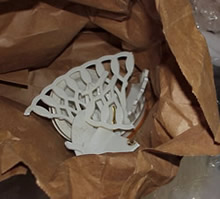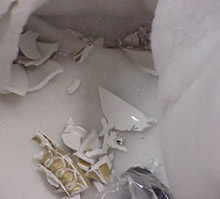|
Q. Will restoration
devalue my piece?
A. NO! That's a misunderstanding from statements made
by the Antiques Roadshow, which tells you not to strip the original finish
off your Chippendale sideboard! The damage that has occurred, causing
you to seek restoration has already devalued it. Professional, non-aggressive
conservation and restoration will only help to bring it back closer to
its original condition, therefore maintaining its value. Now, amateur
repairs, and unnecessary 'restoration' or removing of original finish
and patina, and work done by people without professional training can
most definitely cause further damage to the piece therefore devaluing
it. Always check references and qualifications and ask questions! (Note:
Professional conservation takes several years of intensive, professional
training, apprenticeships, chemistry, art history and studio art studies,
and/or graduate school. It is not a craft, a do-it-yourself project, or
a hobby!)
Q. How much will it cost to fix my artwork?
A. That depends greatly! Most work is based on an hourly
charge, and no responsible conservator would give any sort of estimate
without examining the piece first. Damage is not always as straight forward
as you may think, and the restoration is even less so. There are many
variables involved and all avenues need to be explored before coming up
with a treatment proposal. If you're not nearby, you can email photos and measurements (details below) which document the trouble areas and/or
the whole piece and we can start there and perhaps ballpark it, but
firm estimates cannot be made until the piece is tested and examined personally.
And even then surprises occur during treatment and adjustments may need
to be made as things progress.
|
Information
to send with photos:
|
|
Paintings,
Works on Paper
- Measurement
of the canvas, not including the decorative frame. The wooden
frame usually visible from the back is called the stretcher, and
you can measure from edge to edge from the back, or simply the
approximate size from what is visible from the front.
- Measurement
of the tear or hole or area of loss.
- Detail
shots of the damaged areas
- An
overall shot of the front
- An
overall shot of the back
|
Frames
- Overall
measurement
- Detail
shots of losses or damaged areas and measurements of the losses.
Frames
- Overall
measurement of the frame (either inside or outside, but specify
which)
- Detail
shots of the losses or damaged areas and a measurement of the
loss. (For example: 6 inches of lost trim on the bottom, 2 inches
on the left side.)
|
Porcelain,
ceramic, glass, stone
- Overall
shots
- Overall
measurement
- Detail
shots of losses or damaged areas.
|
Q. How do I
ship it to you?
|
A.
We recommend you have the pieces professionally packaged and sent.
Shipping can be safe if it's done correctly, but when done without
benefit of proper packaging and materials you can cause further,
irreparable damage. Our customers have had good luck with chains
like Mailboxes Etc., and Craters and Freighters. Do make sure however,
that the packing store feels confident in their ability to pack
it correctly. Do make sure that with broken ceramic or glassware,
the each piece is wrapped individually in bubble wrap to insure
that they don't rub against each other during shipping and chip
or break further. Make sure the piece is double boxed using a box
with about 2" space all around the wrapped object, filled with
packing peanuts or shredded material, and then placed inside a larger
box with at least 2" of packing material all around. And lastly,
please don't forget to include your contact information! Your name,
address, phone, email and any information relevant to the piece.
 |
 |
|
Each
piece must be wrapped individually or further damage will
occur during shipping
|
Ship
it to us (The New Orleans Conservation Guild, Inc., 3620 Royal Street, New Orleans, LA 70117) the quickest way feasible for you. The shorter the transit
time, the better. And never ship on Thursdays or Fridays -- the
artwork will inevitably sit in a warehouse over the weekend, and
that's never good!
Once we have examined it, we will prepare a treatment report and
estimate, then contact you for your approval. We will then ask for
a credit card number from you, and when the job is complete we will
contact you for payment. You may send a check or use the credit
card number, as you wish. We can also email digital photos of the
completed project if you wish to see it before we send it back.
We will then pack the piece safely and ship it back via Federal
Express.
|
|
Q. Can I use
it again?
A.
That depends. It is not a good idea to use dinnerware again, or rather
best to use only rarely and with caution. And if you intend to use it
again, it's important to let us know BEFORE work begins. A lot of the
adhesives used are NOT non-toxic. And, the paints and glazes can discolor
when exposed to the fats from food and soaps from washing. And of course,
you never want to put them in the dishwasher! It's best to contact us
and let us know what you would like to do with it before the work is proposed.
Most times pieces are done simply to keep the set complete and are used
for display purposes only.
Q. Is it worth restoring?
A. Now that's a tricky question. As conservators, it is a bit of a conflict
of interest to offer an opinion of value. That's generally a question
you have to answer for yourself. Having said that, however, we do realize
that often the cost or restoration exceeds the monetary value of it, or
at least what was paid for it. Remember the value has no bearing on the
cost of restoring it -- it's based on an hourly rate or a formula for
the procedures required. And grandma's flower painting receives the same
care and attention and respect that an old master painting does.
And remember, that right now it's a broken pile of china or a painting
with a huge tear in it or 4 sticks of gold wood! Would you rather have
your piece back and whole again, or would you rather discard it?
Q.
How much is this worth?
A. As above, we can't answer that. But we do offer an independent appraisal
service. Written appraisals are done by local appraisers, experts in their
specific areas, and generally cost $150-200 per item, though some may
cost more.
For collectibles and decorative items that may not be worth the appraisal
cost AND the restoration cost, you can look at eBay to see what the market
bears, or www.Eppraisals.com
or www.Kovels.com
have on-line appraisal services which are very inexpensive.
Now some things, such as functional dinnerware that can be replaced probably
should be replaced rather than restored. It's more cost effective and
you'll have a longer usable life with an un-restored piece. You can check
into websites such as www.replacements.com
or www.eBay.com for
cost and availability of replacements for your pieces.
Q. How long
will the restoration last?
A. Of course it depends upon what specifically you are talking about,
but generally speaking, it should last a hundred years or more if properly
stored and taken care of. And remember that all artwork should be professionally
examined at least once per generation.
Q. Can an average
person have something restored, or do you only work for museums/wealthy
collectors?
A. Sure! Anything that is loved or appreciated can be restored.


New
Orleans Conservation Guild Home Page
Contact us for
more information:
The New Orleans
Conservation Guild, Inc.
3620 Royal
Street
New Orleans, La. 70117
Phone: (504)
944-7900
Fax: (504) 944-8750
restoration@art-restoration.com
|


